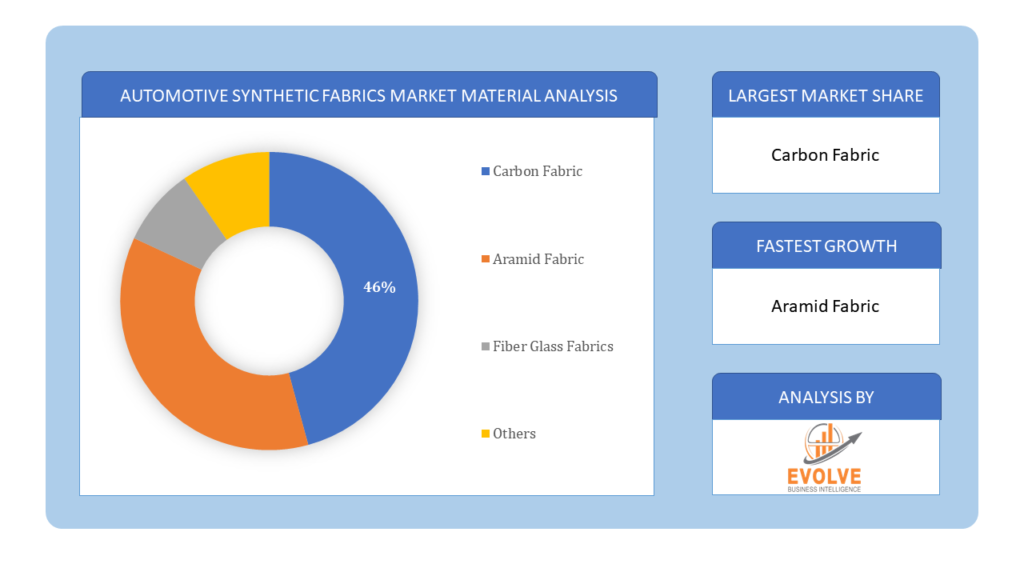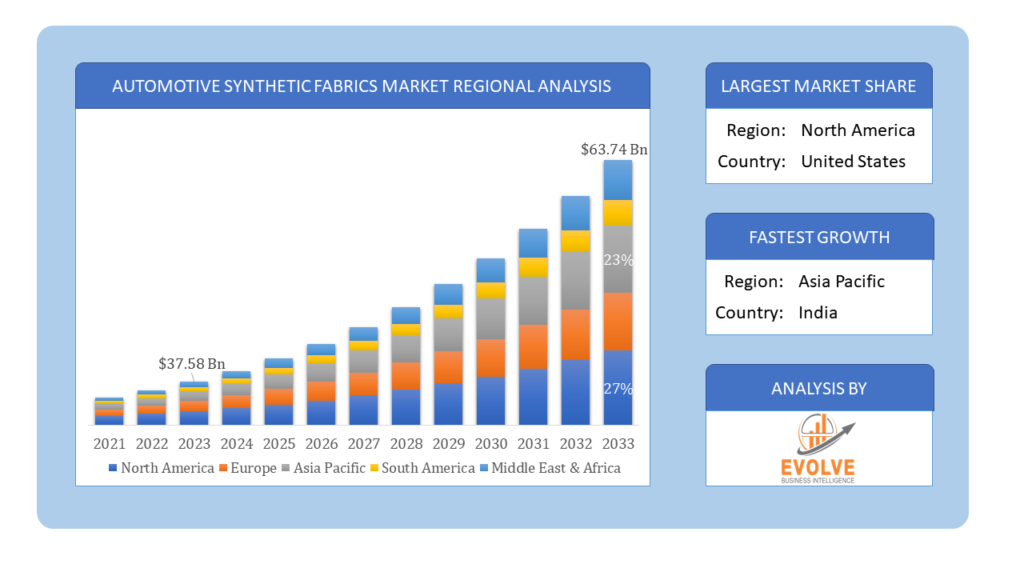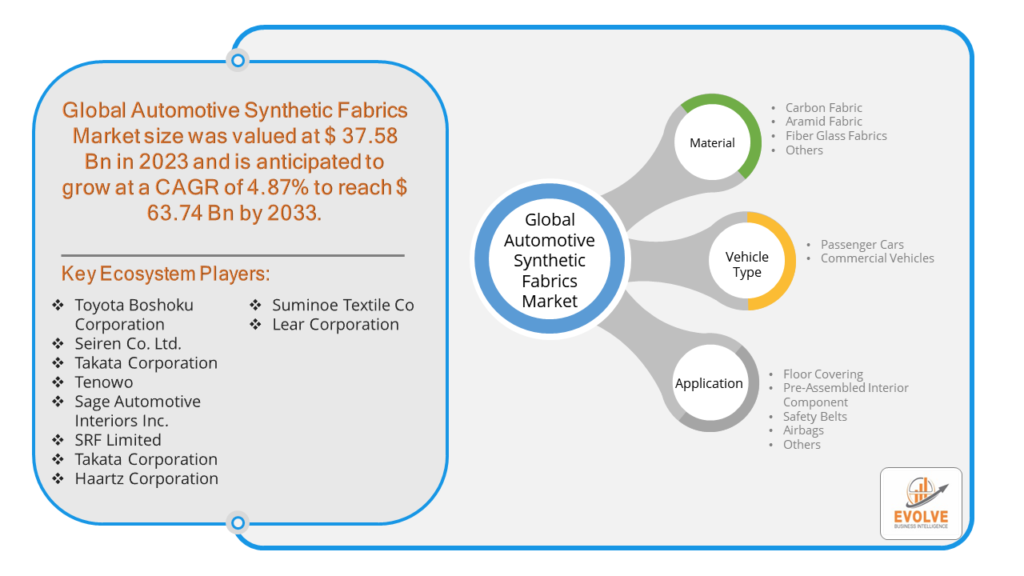Price range: $ 1,390.00 through $ 5,520.00
Automotive Synthetic Fabrics Market Research Report: Information By Material (Carbon Fabric, Aramid Fabric, Fiber Glass Fabrics, Others), By Application (Floor Covering, Pre-Assembled Interior Component, Safety Belts, Airbags, Others), By Vehicle Type (Passenger Cars, Commercial Vehicles), and by Region — Forecast till 2033
Page: 159
Description
Automotive Synthetic Fabrics Market Overview
The Automotive Synthetic Fabrics Market Size is expected to reach USD 63.74 Billion by 2033. The Automotive Synthetic Fabrics Market industry size accounted for USD 37.58 Billion in 2023 and is expected to expand at a compound annual growth rate (CAGR) of 4.87% from 2023 to 2033. The Automotive Synthetic Fabrics Market refers to the global market for synthetic fabrics used in the automotive industry. These fabrics are primarily used in the interior and exterior components of vehicles, such as seats, headliners, carpets, door panels, and other upholstery. The market includes a variety of synthetic materials such as polyester, nylon, acrylic, and polypropylene.
The Automotive Synthetic Fabrics Market is an integral part of the automotive supply chain, catering to the evolving needs of car manufacturers and consumers for high-performance, durable, and aesthetically appealing materials.
Global Automotive Synthetic Fabrics Market Synopsis
The The COVID-19 pandemic had a significant impact on the Automotive Synthetic Fabrics Market. Many automotive manufacturing plants were temporarily shut down due to lockdowns and social distancing measures, leading to reduced production of vehicles and, consequently, synthetic fabrics. The pandemic disrupted the supply chain for raw materials needed to produce synthetic fabrics, such as polymers and chemicals, causing delays and increased costs. Restrictions on transportation and international trade resulted in delays and increased costs for shipping raw materials and finished products. The overall decline in consumer spending and economic uncertainty led to a significant drop in vehicle sales, reducing the demand for synthetic fabrics used in automotive interiors and exteriors. The pandemic prompted a shift in consumer preferences towards more affordable and practical vehicles, impacting the types of fabrics in demand. The pandemic accelerated the adoption of innovative fabric technologies, such as antimicrobial treatments and sustainable materials, to meet changing consumer demands.
Automotive Synthetic Fabrics Market Dynamics
The major factors that have impacted the growth of Automotive Synthetic Fabrics Market are as follows:
Drivers:
Ø Technological Advancements
Continuous innovation in fabric technology, such as the development of new polymers and treatments, is driving market growth. This includes advancements in antimicrobial properties, UV resistance, and flame retardancy. The integration of smart fabrics that can monitor and adjust to environmental conditions or user preferences is an emerging trend that is expected to drive future growth. Rapid urbanization and economic growth in emerging markets are leading to increased automotive production and sales, thereby boosting demand for synthetic fabrics. The rising demand for luxury and premium vehicles, which often feature high-quality interior materials, is contributing to the growth of the synthetic fabrics market.
Restraint:
- Perception of Environmental Concerns
Many synthetic fabrics are not biodegradable, leading to environmental concerns regarding their disposal and long-term impact on landfills. The production of synthetic fabrics often involves the use of chemicals and processes that can contribute to pollution, raising environmental and regulatory challenges. Some consumers prefer natural materials like leather and cotton for their perceived quality, comfort, and aesthetic appeal, which can limit the demand for synthetic alternatives. In the high-end luxury vehicle segment, natural materials are often favored over synthetic fabrics, impacting the market share of synthetic options.
Opportunity:
⮚ Growing demand for Advanced Fabric Technologies
Integrating smart technologies into synthetic fabrics, such as temperature regulation, moisture wicking, and embedded sensors, can enhance the functionality and appeal of automotive interiors. Increasing demand for hygienic and health-conscious materials can drive the development of antimicrobial synthetic fabrics, especially in the post-pandemic landscape. Utilizing digital tools and technologies for fabric design and customization can streamline production processes and reduce time-to-market. Expanding sales and marketing efforts through online platforms and digital marketplaces can reach a broader audience and facilitate direct-to-consumer sales.
Automotive Synthetic Fabrics Market Segment Overview
By Material
 Based on Material, the market is segmented based on Carbon Fabric, Aramid Fabric, Fiber Glass Fabrics and Others. The Fiber Glass Fabrics segment dominant the market. Fiber Glass Fabrics are composed of fine fibers of glass woven into a fabric. These fabrics are known for their high strength, lightweight properties, and resistance to heat and chemicals, making them suitable for various automotive applications. Automotive manufacturers are increasingly seeking lightweight materials to improve fuel efficiency and meet stringent emission regulations. Fiber glass fabrics provide an ideal solution due to their lightweight nature and strength.
Based on Material, the market is segmented based on Carbon Fabric, Aramid Fabric, Fiber Glass Fabrics and Others. The Fiber Glass Fabrics segment dominant the market. Fiber Glass Fabrics are composed of fine fibers of glass woven into a fabric. These fabrics are known for their high strength, lightweight properties, and resistance to heat and chemicals, making them suitable for various automotive applications. Automotive manufacturers are increasingly seeking lightweight materials to improve fuel efficiency and meet stringent emission regulations. Fiber glass fabrics provide an ideal solution due to their lightweight nature and strength.
By Vehicle Type
Based on Vehicle Type, the market segment has been divided into the Passenger Cars and Commercial Vehicles. The passenger cars segment dominated the market. Passenger cars have the highest production volume compared to other vehicle segments, such as commercial or off-road vehicles. The sheer volume of passenger cars manufactured annually creates a substantial demand for automotive fabrics, including upholstery, carpets, headliners, and seat covers.
By Application
Based on Application, the market segment has been divided into the Floor Covering, Pre-Assembled Interior Component, Safety Belts, Airbags and Others. The airbags segment dominated the market. Airbags are essential to vehicle safety systems, mandated by regulatory bodies worldwide. Airbags play a crucial role in reducing the risk of injury and saving lives during vehicle collisions. Their ability to deploy rapidly and provide cushioning to occupants during a crash makes them indispensable safety features in modern vehicles, ensuring their dominance in the automotive fabrics market.
Global Automotive Synthetic Fabrics Market Regional Analysis
Based on region, the global Automotive Synthetic Fabrics Market has been divided into North America, Europe, Asia-Pacific, the Middle East & Africa, and Latin America. North America is projected to dominate the use of the Automotive Synthetic Fabrics Market followed by the Asia-Pacific and Europe regions.
 Automotive Synthetic Fabrics North America Market
Automotive Synthetic Fabrics North America Market
North America holds a dominant position in the Automotive Synthetic Fabrics Market. The region is known for its early adoption of advanced technologies, including innovative synthetic fabrics with enhanced properties like antimicrobial and UV resistance. There is strong demand for high-quality, durable, and aesthetically pleasing automotive interiors. Increased consumer preference for personalized and luxurious vehicle interiors can drive demand for premium synthetic fabrics.
Automotive Synthetic Fabrics Asia-Pacific Market
The Asia-Pacific region has indeed emerged as the fastest-growing market for the Automotive Synthetic Fabrics Market industry. Asia-Pacific is a major manufacturing hub for synthetic fabrics, benefiting from lower production costs and economies of scale. Rapid urbanization and economic growth are driving increased automotive production and sales, particularly in countries like China and India. Consumers in this region are often more cost-sensitive, influencing the demand for affordable synthetic fabric options.
Opportunities:
Emerging Markets: Significant growth potential exists in emerging markets, where rising disposable incomes and increased vehicle ownership drive demand.
Competitive Landscape
The global Automotive Synthetic Fabrics Market is highly competitive, with numerous players offering a wide range of software solutions. The competitive landscape is characterized by the presence of established companies, as well as emerging startups and niche players. To increase their market position and attract a wide consumer base, the businesses are employing various strategies, such as product launches, and strategic alliances.
Prominent Players:
- Toyota Boshoku Corporation
- Seiren Co. Ltd.
- Takata Corporation
- Tenowo
- Sage Automotive Interiors Inc.
- SRF Limited
- Takata Corporation
- Haartz Corporation
- Suminoe Textile Co
- Lear Corporation
Key Development
In April 2023: Autoliv, Inc., the global frontrunner in automotive safety systems, has revealed its intention to construct a cutting-edge airbag cushion and fabric manufacturing facility in Vietnam to serve the Asian region. This strategic investment in the new textile plant directly responds to heightened customer requirements. It aims to serve the growing market for airbag production in the rapidly expanding Asian market.
Scope of the Report
Global Automotive Synthetic Fabrics Market, by Material
- Carbon Fabric
- Aramid Fabric
- Fiber Glass Fabrics
- Others
Global Automotive Synthetic Fabrics Market, by Vehicle Type
- Passenger Cars
- Commercial Vehicles
Global Automotive Synthetic Fabrics Market, by Application
- Floor Covering
- Pre-Assembled Interior Component
- Safety Belts
- Airbags
- Others
Global Automotive Synthetic Fabrics Market, by Region
- North America
- US
- Canada
- Mexico
- Europe
- UK
- Germany
- France
- Italy
- Spain
- Benelux
- Nordic
- Rest of Europe
- Asia Pacific
- China
- Japan
- South Korea
- Indonesia
- Austalia
- Malaysia
- India
- Rest of Asia Pacific
- South America
- Brazil
- Argentina
- Rest of South America
- Middle East & Africa
- Saudi Arabia
- UAE
- Egypt
- South Africa
- Rest of Middle East & Africa
| Parameters | Indicators |
|---|---|
| Market Size | 2033: $63.74 Billion |
| CAGR | 4.87% CAGR (2023-2033) |
| Base year | 2022 |
| Forecast Period | 2023-2033 |
| Historical Data | 2021 |
| Report Coverage | Revenue Forecast, Competitive Landscape, Growth Factors, and Trends |
| Key Segmentations | Material, Vehicle Type, Application |
| Geographies Covered | North America, Europe, Asia-Pacific, Latin America, Middle East, Africa |
| Key Vendors | Toyota Boshoku Corporation, Seiren Co. Ltd., Takata Corporation, Tenowo, Sage Automotive Interiors Inc., SRF Limited, Takata Corporation, Haartz Corporation, Suminoe Textile Co and Lear Corporation. |
| Key Market Opportunities | • The growing demand for Advanced Fabric Technologies • Digital Transformation |
| Key Market Drivers | • Technological Advancements • Growth in Automotive Production |
REPORT CONTENT BRIEF:
- High-level analysis of the current and future Automotive Synthetic Fabrics Market trends and opportunities
- Detailed analysis of current market drivers, restraining factors, and opportunities in the future
- Automotive Synthetic Fabrics Market historical market size for the year 2021, and forecast from 2023 to 2033
- Automotive Synthetic Fabrics Market share analysis at each product level
- Competitor analysis with detailed insight into its product segment, Government & Defense strength, and strategies adopted.
- Identifies key strategies adopted including product launches and developments, mergers and acquisitions, joint ventures, collaborations, and partnerships as well as funding taken and investment done, among others.
- To identify and understand the various factors involved in the global Automotive Synthetic Fabrics Market affected by the pandemic
- To provide a detailed insight into the major companies operating in the market. The profiling will include the Government & Defense health of the company’s past 2-3 years with segmental and regional revenue breakup, product offering, recent developments, SWOT analysis, and key strategies.
Frequently Asked Questions (FAQ)
What is the growth rate of the Automotive Synthetic Fabrics Market?
The Automotive Synthetic Fabrics Market is expected to expand at a compound annual growth rate (CAGR) of 4.87% from 2023 to 2033.
Which region has the highest growth rate in the Automotive Synthetic Fabrics Market?
The Asia-Pacific region has emerged as the fastest-growing market for the Automotive Synthetic Fabrics industry.
Which region has the largest share of the Automotive Synthetic Fabrics Market?
North America holds a dominant position in the global Automotive Synthetic Fabrics Market.
Who are the key players in the Automotive Synthetic Fabrics Market?
Key players in the Automotive Synthetic Fabrics Market include Toyota Boshoku Corporation, Seiren Co. Ltd., Takata Corporation, Tenowo, Sage Automotive Interiors Inc., SRF Limited, Haartz Corporation, Suminoe Textile Co, and Lear Corporation.
Additional information
| Packages | Single User License, Enterprise License, Data Pack Excel |
|---|
Table of Content
[html_block id="7100"]


